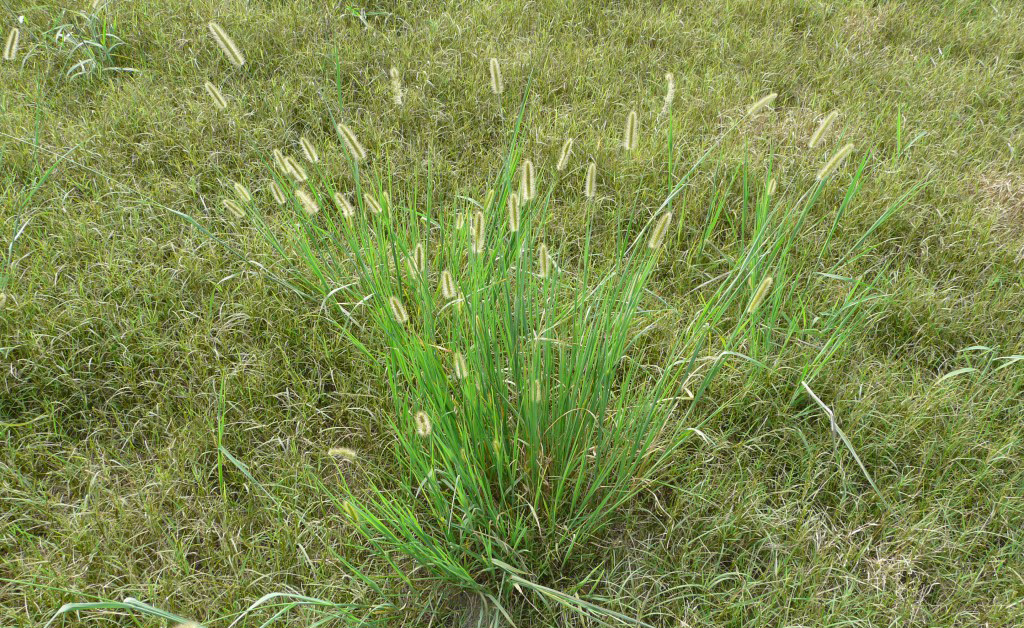
By John Nelson, Extension Educator in Lancaster County
Perennial systems like pasture and grass hay fields present some of the most difficult weed control scenarios for producers and acreage owners in southeast Nebraska. Summer annual grasses, particularly foxtail species, have been especially troublesome in recent years.
The consensus among pasture and hay experts is that a healthy and vigorous hay stand is the most effective and cost-efficient method to control weeds. The past two years of drought have made it difficult to maintain competitive pastures and hay fields in southeast Nebraska, so unfortunately, problems with weed control in these systems are to be expected.
Many factors can contribute to a grass pasture losing its ability to compete with weeds. The aforementioned drought conditions naturally lead to overgrazing and improper haying. Grazing too heavily or at the wrong time, or cutting hay at the improper grass growth stage can lead to stand loss. When stand loss occurs, especially in suboptimal growing conditions, weeds can easily invade. Once weeds take over, it can be difficult and expensive to re-establish desirable grass.
Pasture management is a long-term project, with very few quick fixes available for producers. The most prudent course of action in achieving a productive and profitable pasture or hay field is to continually monitor and manage the entire system, including grazing/haying, fertility and herbicide usage.
FERTILIZING IS KEY TO A HEALTHY PASTURE
Proper fertilization is one key to maintaining a healthy and competitive stand. Smooth brome requires annual nitrogen fertilization, which can be done in the spring, late summer or split applied, depending on the grazing or haying production system.
Phosphorus fertilization is also recommended in smooth brome pastures in eastern Nebraska. Phosphorus recommendations are based on the availability of phosphorus as measured by a soil test. Phosphate fertilizers can be applied with nitrogen in either the spring or fall. Most research in eastern Nebraska has shown that pastures do not usually respond to potassium fertilization, due to the high natural levels in the soil.
More details on pasture and hay fertilization can be found in Nebraska Extension NebGuide “Fertilizing Grass Pastures and Hayland” (G1977), at https://extensionpubs.unl.edu/publication/1147.
CONTROLLING FOXTAIL
Grassy weed species such as foxtail can be especially difficult to control in grass pastures and hay fields. Because of the similarities between pasture grass species and grassy weeds, herbicide options are limited for the control of weeds such as foxtail.
Kansas State University conducted a study in northeast Kansas to evaluate three different herbicides — pendimethalin (Prowl H2O), metsulfuron (Escort XP) and S-metolachlor (Dual II Magnum) — for pre-emergence control of foxtail in smooth bromegrass hay fields. Because these herbicides are only for pre-emergence control, application timing is critical.
Pre-emergence herbicides must be applied before weed seeds germinate, so the researchers chose to make applications in late March and mid-June, after hay harvest. Of the three herbicides tested, the March applications of Prowl H2O were significantly more effective than any other herbicide or application timing, controlling 97% of emerging foxtail (see graph at https://eupdate.agronomy.ksu.edu/article_new/foxtail-infestations-in-smooth-bromegrass-hay-meadows-430-2).
From this study, one can see making weed control decisions early in the spring is critical to managing infestations of grassy weeds in pastures. The data also shows that there was some control from the June herbicide applications, but all products controlled less than 40% of the foxtail when applied later in the season.
FOR MORE INFORMATION
Extension publications for pasture and grass hay are listed at https://croptechcafe.org/extension-publications-for-pasture-and-grass-hay.